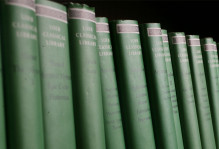Inside the sausage factory
Over a century ago, the German statesman Otto Von Bismarck supposedly said, “If you like laws and sausages, you should never watch either one being made.” Same point can be made about the way I construct course syllabi. For instance, my freshman seminar about American political institutions begins in about five weeks and I am now settling on the reading list, which is at the core of any college class. I have some key strategic decisions to make about the class, beginning with the contents of the syllabus.
One common approach is to assign two or three textbook treatments – big books from commercial publishers that are written with a student audience in mind. It would be easy to find a few well-written textbooks about political parties, the Congress, the president, and so on. The advantage of the textbook approach is that the readings will have a lot of breadth, be generally accessible to students, and maybe even include nifty cartoons. The downside is that even the best college-level textbooks are not pitched at students who are as bright, well-prepared, and highly motivated as W&M students (and no, I’m not currying favor here – I already have tenure and can’t be fired).
A second approach is for me to instead assign five or six scholarly treatises that touch on the central institutions of our national government. By “scholarly treatise,” I am referring to more thematic books published by major academic presses that are primarily intended for professional audiences and graduate students, as well as selective undergraduate audiences. The advantage of using treatises is that they tend to present an argument, rather than simply describe how governing institutions work, and also are more sophisticated and analytically demanding. The disadvantages, however, are that in the aggregate these books almost certainly won’t touch on every topic of importance to my class (for example, none of the books may focus on interest groups or the role of the media) and scholarly treatises tend to be a lot more challenging for the students, who for this class all will be first-semester freshmen, completely new to the college experience.
So there are some serious tradeoffs here. Over the years, I’ve experimented with both approaches, but on balance favor the second one, largely because of the quality and intellectual curiosity of most W&M students. Frankly, it’s also a lot more fun for me to teach a course structured around cutting-edge scholarship. As a result, my plan this fall is to use six books, emphasizing recent contributions by leading scholars to what we know about the Congress, presidential selection and governance, and so on, but also including one or two books that are more journalistic and descriptive in content to provide the freshman with an occasional respite. I’ll explore why I am choosing particular books in future posts.


No comments.
Comments are currently closed. Comments are closed on all posts older than one year, and for those in our archive.